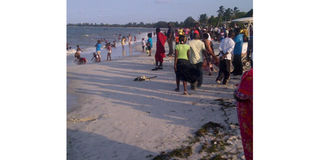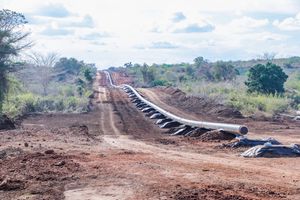How to make Dar’s Beaches a part of daily life

No one should block or limit the public’s use of beaches. All beaches should be 100 percent open for public use. PHOTO | COURTESY
What you need to know:
- No one should block or limit the public’s use of beaches. All beaches should be 100 percent open for public use.
The wretched state of the Dar es Salaam coastline is a matter of grave concern to all with a developmental disposition.
Upon engaging with various individuals on the subject of Dar’s beaches following the publication of my previous article, one individual particularly stood out for his extensive knowledge and fervent passion for the topic.
This individual has personally traversed a distance of 100km along the coastline both north and south of Dar and possesses in-depth familiarity with every cliff and beachfront establishment.
His insights made me realise that, like many residents of Dar, I had been neglecting the beaches.
It took the perspective of a well-travelled foreigner to truly open my eyes to the opportunities that are being overlooked.
According to his analysis, Tanzania has the potential to be a top tourist destination in sub-Saharan Africa, rivalled possibly only by South Africa.
However, other countries with far fewer attractions are currently outnumbering Tanzania in terms of visitor numbers.
Kenya is one such nation. Despite having fewer tourism resources, Kenya has managed to become quite competitive in the tourism industry.
Some beaches in Mombasa are well-developed and draw visitors from around the world, even though Mombasa’s beaches cannot match the beauty and potential of the beaches along Tanzania’s coastline, even if we don’t include those in Zanzibar.
Why do Dar’s beaches fail to compete with other tourist destinations, despite their vast potential? Why do hotels and businesses struggle to attract visitors? And why are the residents of Dar so detached from the waterfront?
The absence of a cohesive plan to integrate Dar’s waterfront into the city’s economy and culture is the main cause of Dar’s failure.
Without proper oversight and coordination, individuals have been able to claim and utilise beach plots for their own purposes, resulting in a lack of progress towards a thriving waterfront.
This means we are reaping exactly what we have sown into the waterfront agenda—nothing.
The temptation here is to assume that if we find investors to develop our beaches, then everything will start to work well. No, it won’t.
The disconnect between residents and the beaches runs deeper, requiring a comprehensive coastal development strategy.
To achieve that, there is a need for a coastline development masterplan to make beaches integral to locals and visitors.
That needs to start with a change in our outlook to reflect the fact that the waterfront is inherently a public asset.
So, no one should block or limit the public’s use of beaches. So, no one should block or limit the public’s use of beaches. All beaches should be 100 percent open for public use.
We similarly need to change our outlook by understanding that beaches are not just places for leisure and entertainment.
This one-dimensional view is one of the reasons existing investments have struggled to make a big splash in changing the way people interact with the beaches.
Beaches should be integral to how people live.
That can be achieved by making waterfronts ‘multi-use’, a place to work, live and play.
While the idea sounds like a cliché nowadays, it represents the best ideas in city planning and real estate developments today.
Projects that thrive are those that incorporate multiple uses of the space in question.
The authors of the Dar-Bagamoyo Waterfront Development Initiative that I referenced in the prequel to this article did excellent work in highlighting multiple uses for Dar’s coastline.
They envisioned a waterfront economic corridor from the edges of Dar’s region in the south to Bagamoyo in the north.
They planned to invest heavily in a variety of projects, including green eco-parks, river, marsh, and mangrove forest rehabilitation, hotels, restaurants, food courts, office and residential accommodations, higher learning institutions, Formula One training and go-cart racing tracks, casino gaming and amusement parks, leisure, and medical and health centres.
That is indeed multi-use.
One of the things that the multi-use factor will achieve is the encouragement of round-the-clock use of the beach.
That is what the stated vision will do—unlock the coastline’s potential as both an economic corridor and a space for leisure.
That said, while the multi-use factor will go a long way towards attracting people to the ocean, without a common thread connecting all the developments into a shared experience, it might take time for beach life to become integral to how people live.
It is crucial to physically connect the many spaces and developments into one experience to address this.
Building an oceanfront highway that integrates all the developments from the south to the north will provide that solution.
The highway should be linked with walkways, trams, boats, and ferries.
The end result will be a highly prized beach experience, capable of attracting enthusiasts from far away and giving those who are visiting the city a reason to explore it as tourists.
To truly make a difference, we also need a radical overhaul of our sewage and waste management systems in this city.
One commenter on my previous article bemoaned the state of the beach near Aga Khan Hospital, citing improper sewage disposal and garbage management as the root cause of its deplorable state.
It is time to proactively manage our urban systems before it is too late.
Transforming an urban monstrosity like Dar is a monumental task. Similarly, creating thriving economic opportunities on its beaches will not be child’s play.
But with a clear vision and determination, it is possible to make Dar’s beaches the bustling corridor of opportunities that they should be.
The dividends will be massive.




